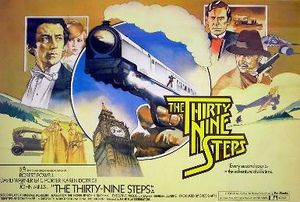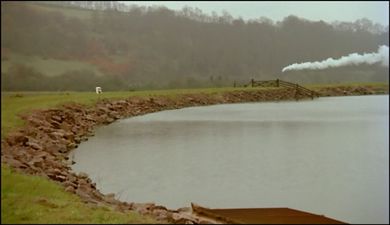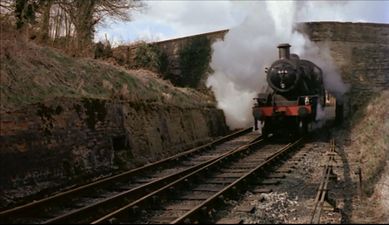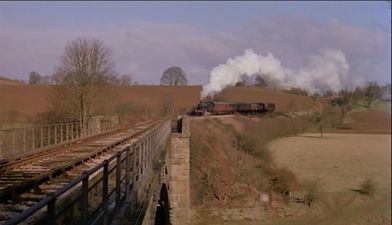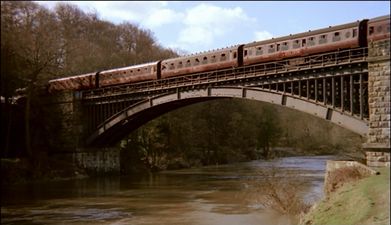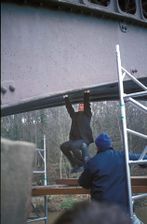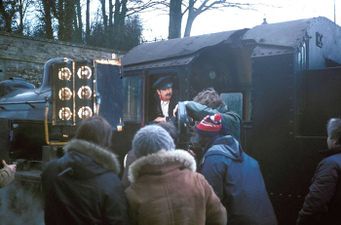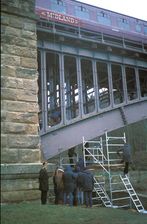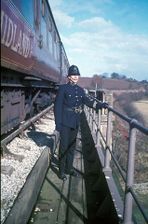The Thirty Nine Steps
The Thirty Nine Steps was a 1978 film adaptation of the adventure novel 'The Thirty-Nine Steps' by Scottish author John Buchan, first published in 1915. It was directed by Don Sharp, produced by Norfolk International Pictures for the Rank Organisation and featured Robert Powell as Richard Hannay, Karen Dotrice as Alex, John Mills as Colonel Scudder, and a number of other well-known British actors in supporting roles.
During the film Hannay flees to Scotland on a train, but is forced to make a daredevil escape on a bridge after police board the train. The railway action scenes were filmed on the SVR.
Contents
Filming on the SVR
The railway sequence, set in early 1914, begins in the ticket office at London St Pancras Station. The action scenes used LMS Ivatt Class 2 46443 (in MR livery as No 644) and five of the SVR's LMS carriages with 'Midland' stickers applied. The scenes filmed on the SVR, which last around 5 minutes in total, comprise:
- Hannay boarding the train (filmed on the island platform at Bewdley)
- A wide shot of the train passing the Spring Grove area just west of Bewdley Tunnel
- A distant shot of the train passing Trimpley Reservoir (re-used in the 1980 film The Elephant Man)
- The train crossing Oldbury Viaduct
- A lineside shot of the train just west of Bewdley Tunnel
After a cutaway to a short scene where his pursuers order all trains leaving St Pancras to be searched, the railway sequence continues:
- The train on Eardington Bank
- The train from emerging from Arley Station Bridge having passed through the station at speed (re-used in the 1980 film The Elephant Man). #
- The train passing through a station at speed, filmed from a footbridge over the line (Bewdley again).
- A brief lineside shot on an embankment (location uncertain)
- The train stopping at another station (Highley) where the police come aboard and the train is seen setting off again. #
- Film of the police searching the train (between Highley and Arley?) #
- The train approaching the bridge, where Hannay pulls the communication cord to bring it to an emergency stop. #
- The escape scene on the bridge. #
- A parting shot of the train setting off through Eymore Cutting.
- Hannay climbing down from the bridge.
For most of the early scenes the locomotive is facing north. In the escape scene and other scenes marked # it was turned to face south.
The main escape scene was filmed on Victoria Bridge and also featured the first film speaking part for an SVR 'extra' - the driver shouting out "Come on, there's another train due, come on!" was the SVR's John Price.[1] Another SVR volunteer, Barrie Geens, played the part of a policeman during the search on the train, for which he was paid £7 a day for the week, plus "lots of free food".[2]
Hannay’s train journey is via the Midland Railway from their London terminus at St Pancras to Dumfries. The film contains several anachronisms and 'oddities':
- Although the train journey is set in 1914, the locomotive and carriages are of a more modern (late LMS) appearance.
- The 'Midland Railway' carriage that Hannay boards carries the number W24617M, a BR era number for an ex-LMS carriage allocated to the BR Western Region. A "First Class" symbol on his carriage window is also in the BR ‘Totem’ style.
- As the train first sets off, a number of GWR carriages are visible through the window. It is unlikely that GWR carriages would have been at St Pancras in 1914.
- During the first sequence, the train is seen on a single track line, unlikely for a mainline express route from St Pancras to the north.
- The escape scene takes place on a fictional bridge in Scotland, presumably south of Dumfries which was Hannay’s destination. The landscape at Arley is rather out of character for that area.
Other adaptations
The 1935 Alfred Hitchcock film 'The 39 Steps', which was only loosely based on the novel, starred Robert Donat and Madeleine Carroll. It was remade under the same title in 1959, starring Kenneth More and Taina Elg. Both versions used a contemporary setting.
The Thirty Nine Steps was the third film adaptation of the book and is generally regarded as the closest to the novel, both being set just before the First World War. The film’s producer Greg Smith claimed "the Hitchcock version was about 20 percent Buchan and 80 percent Hitchcock. Our goal was to turn it around and make the film 80 percent Buchan and 20 percent invention."
A spin-off television series Hannay, also featuring Robert Powell, included scenes filmed on the SVR during 1987. It ran for 13 episodes from 1988 to 1989.
